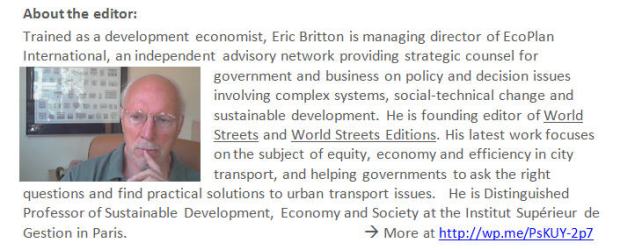 We understand that in the transport sector this is not a well known or much appreciated concept, at least in the positive sense we are trying to develop here, so we are making every effort to clarify. I was discussing this program the other day with a bright young woman from the Emirates who is on an MBA program here, who smiled at me indulgently as I asked her views and said: ‘Don’t you understand Eric, life is not fair”. That gives us, I would say, a good point of departure.
We understand that in the transport sector this is not a well known or much appreciated concept, at least in the positive sense we are trying to develop here, so we are making every effort to clarify. I was discussing this program the other day with a bright young woman from the Emirates who is on an MBA program here, who smiled at me indulgently as I asked her views and said: ‘Don’t you understand Eric, life is not fair”. That gives us, I would say, a good point of departure.
The first step in this process is to see if we can create a common understanding of our topic and the strategy that goes with it – bearing in mind the fact that in most cities in the world, probably all of them to be perfectly frank and accurate, our transportation arrangements are not equitable, indeed far from it. There are winners and losers from the present mobility arrangements, worse here, perhaps a bit better there.

In all places, better and worse, there is a basic dominant pattern. Let’s call it if not a paradigm at least an inevitable result of the dominant paradigm now firmly in place. A paradigm that is so deeply engraved as part of the received wisdom, that it is all but invisible. But the results are there for all to see.
Thus as a result of this invisible paradigm women in virtually every city in the world are by and large less well served than men. Non-drivers less well than drivers. The elderly and frail less than the active and healthy. Children less well than adults,. The poor far less well than the rich. The unemployed less well than those with jobs. Those of us who cannot really (that “really” is an important word that we shall also be looking into) afford to own and operate cars as opposed to those who can. And if you care to think about it a bit, you can surely complete this list as well as I.
In a word, in most cities on this gasping planet for the great majority of all people the present transportation arrangements are inequitable. The dominant (a) all-car (b) no-choice transportation arrangements of the 20th century are not doing the job for the transportation majority. They are grotesquely unfair; they are also highly inefficient, socially and environmentally destructive and unaffordably uneconomic.
Turning it around
So what if we were to turn the situation around and take as a starting point for public policy and investments not so much the dominant twentieth century values of speed (ever faster), distance (ever farther) and indifference (ever more) but 21st-century values of equity, frugality (this is not a negative word), social justice and deep democracy? And that of course is what this project is all about.
One of the key pillars behind this program is a belief that, properly engaged, the move to equity-based transportation can lead to greater efficiency and economy both for specific groups and individuals, and also for the city and its region as a whole. That it is to say that it is going to be a step up, not a step down!
If we redraw the system to make it better for women of all ages and life condition, it will be better for men as well. Better for the frail and elderly, then better for the rest as well. Better and safer for children, then better and safer for all. Better for the poor, then well, believe it or not, better for the rich as well.
At the end of the day, once you understand and accept the basic principle of equity a huge number of other good things follow: quality of life for all, resource and energy efficiency, financial integrity, new targets for entrepreneurship, technology and innovation, local environmental and planetary climate impacts, social peace and solidarity. The present we want for ourselves, our families and neighbors. The future that we want for our children and grandchildren and future generations.
And you have only to look in one place to see if you have it — and that is on the streets of your city. If the mayor, all public servants, and the top economic 20% of your community travel by the same means as the other 80%, you have an equitable system. If not, not! It’s that simple.
With that behind us, now we know where to start.
# # #


This is one of the topics which is of great interest to me. Whereas transport facilitates almost everything we do, there is not much mobilisation around the subject. We need to stimulate greater interest in the area of transport. That way there will be more champions of equitable transport[ation].
LikeLike